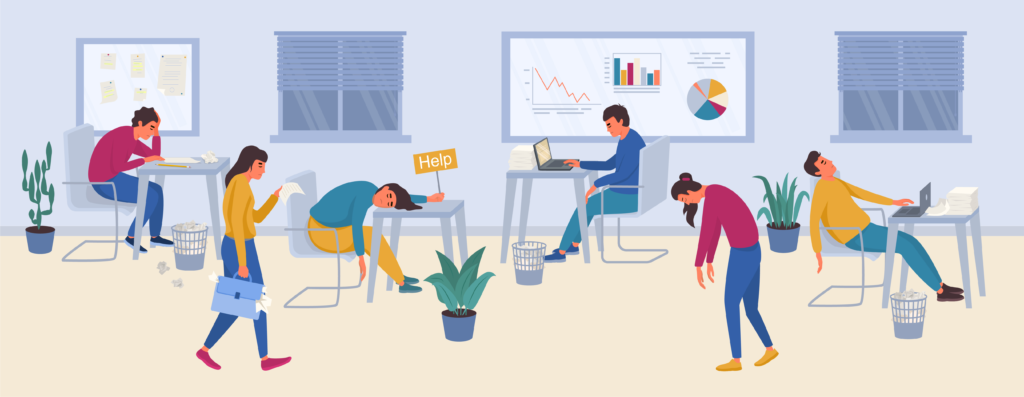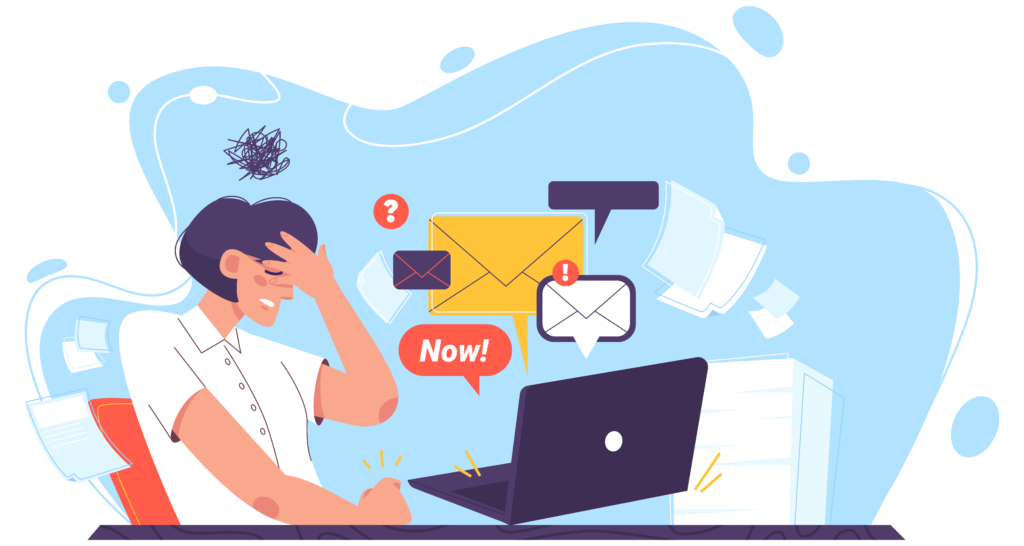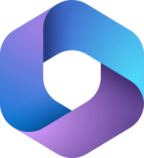In today’s fast-paced digital world, constant distractions and overwhelming collaboration often push meaningful work aside. As a result, managing your attention has become the most important factor to staying productive.
In this article, we will explore how leaders can tackle these challenges using attention management in Microsoft 365 tools.

Why We’re All So Busy, But Not Productive
Ever had one of those days where you were super busy, but at the end of the day, you feel like you didn’t really get anything done? 🤔 That’s the modern workplace struggle in a nutshell.
Let’s break it down and understand why it’s happening!
Where’s All the Time Going?
It’s surprising to learn that the average employee dedicates only 44% of their time to the core responsibilities they were originally hired for.
Instead of focusing on their main job duties, a significant portion of their workday gets eaten up by other tasks and distractions. This means that less than half of their time is spent on the essential activities that align with their primary role.

So, what’s eating up the other 56% of your day?
Around 40% of that time ends up being wasted on internal emails that don’t really accomplish anything and don’t really add much value.
Picture this:
You’re deep in work, trying to focus, when a notification pops up—another email thread that’s already 10 replies long. Everyone’s chiming in, offering their opinion, but no one is making any real decisions.
Before you know it, you’ve spent an hour just scrolling through, adding your own reply, and still, the issue remains unresolved. It’s frustrating because all this back-and-forth feels more like noise than progress, yet it happens over and over again.

Studies show that only around 25% of what influences an employee’s performance is linked to doing meaningful work.
Where’s the remaining 16% of your day?
On average, 16% of the workday is used for administrative or non-core tasks, such as attending meetings, organizing documents, or filing reports. These activities, while important, are not directly related to the primary responsibilities of the job, but they still take up a significant portion of time.
Consider this:
When you’re doing work that really matters, it fuels you, right? when your tasks feel important and impactful, they energize and drive you. However, when that meaningful work is lost in a sea of emails, meetings, and constant distractions, it’s easy to see why your motivation starts to drop. The distractions take over, leaving you feeling less engaged and less productive.
Understanding Productivity
Productivity refers to the measure of how effectively individuals, teams, or organizations utilize their resources—such as time, labor, and materials—to produce goods or services. It reflects the efficiency with which tasks are completed and goals are achieved.

Key Aspects of Productivity:
1) Output vs. Input
Productivity is often calculated as the ratio of output (what is produced) to input (resources used). For example, in a factory, productivity can be measured by the number of products made per hour.
2) Time Management
Effective time management is important for enhancing productivity. Prioritizing tasks and minimizing distractions can help individuals focus on high-impact activities.
3) Quality of Work
Productivity isn’t just about quantity; the quality of the output is equally important. Producing high-quality work can lead to better outcomes and increased satisfaction among stakeholders.
4) Tools and Technology
Utilizing the right tools and technology can streamline processes, automate repetitive tasks, and enhance overall efficiency.
5) Work Environment
A supportive and well-organized work environment can boost productivity. This includes factors like workplace culture, collaboration among team members, and availability of resources.
6) Motivation and Engagement
Employee motivation plays a significant role in productivity. Engaged employees who find meaning in their work are often more productive than those who feel disengaged or overwhelmed.
Overall, productivity is about achieving goals efficiently and effectively while maintaining a focus on quality and well-being.
The Productivity Equation
We can also define productivity as a combination of two elements:
Technology × Attention = Productivity
This equation underscores that technology alone cannot guarantee productivity. It must be paired with balance focus and attention management to drive meaningful work.
Tools like Microsoft Copilot and Microsoft Viva are highlighted as enablers of this approach, providing structured methods to reduce distractions and support deep work.
The 3Ps of Productivity: Purpose, People, Progress
There are three fundamental elements that contribute to a productive workday: Purpose, People, and Progress. These are the driving forces that create a sense of meaning and motivation, helping employees achieve satisfaction in their work.
1) Purpose
Purpose refers to understanding the value of one’s work and feeling connected to meaningful goals.
When employees know the why behind their work, they engage more deeply. Without that sense of purpose, they’re just going through the motions. In fact, up to 25% of their performance is linked to this feeling of meaning. Think of it as the secret sauce that keeps people motivated.
2) People
People play important role by focusing on collaboration and support among team members, creating a positive work environment.
- Collaboration is important for getting things done, but it can easily become too much to handle.
- While working together as a teamwork is necessary for success, it can also be one of our biggest distractions.
Over the past ten years, the amount of collaboration has increased by 50%, and in fact, we spend about 85% of our day on tasks that involve teamwork. However, when collaboration becomes excessive, the quality of our work can suffer, and instead of making progress, we may end up feeling tired and overwhelmed, which can hinder our overall effectiveness.
It’s essential to find a balance that allows us to work together without losing focus or motivation.
3) Progress
Progress refers to the sense of achievement employees feel when they move forward on important projects.
There’s nothing quite like the satisfaction of making real progress on important tasks. However, during hectic days, many employees feel as if they’re stuck in a never-ending cycle—putting in a lot of effort but not actually getting anywhere.
Research highlights that the feeling of progress is a key motivator for employees. When individuals see that their hard work is leading to tangible results, they are more likely to stay engaged and motivated.
Unfortunately, distractions can easily block this sense of achievement. When employees are constantly interrupted or faced with overwhelming tasks, their progress feels stunted. This lack of advancement can lead to frustration, making it harder for them to stay focused and productive.
“What is scarce in all of the abundance is human attention.” – Satya Nadella, CEO
Understanding Attention
Attention can be defined as the mental process of selectively concentrating on a particular task, subject, or stimulus while ignoring other distractions.
In the context of productivity and focus, attention involves managing three key dimensions:
- Direction (focusing on the right tasks and priorities),
- Depth (achieving intense focus or “deep work” without interruptions), and
- Duration (maintaining sustained concentration over a set period of time). Effective attention management is critical to achieving productivity, especially in modern work environments where distractions are abundant. Tools like Microsoft 365 and AI can aid in harnessing attention to enhance focus and output.
Managing Attention: Direction, Depth, and Duration
1) Direction: Focusing on the Right Tasks
Direction is all come down to what you’re focusing on. Imagine your attention as a flashlight. Wherever you shine that light is where your energy and effort will go.
If your flashlight keeps jumping from one task to another, you won’t accomplish much. It’s like trying to read a book while the lights keep flickering; you can’t concentrate. But when you focus that light on one task, you can see it clearly and work effectively.
When you direct your attention to the task at hand, that’s when real progress occurs. You start to complete your work and achieve your goals. Staying focused is essential for getting things done and making the most of your time.
2) Depth: Achieving Intense Focus (Deep Work)
Depth refers to how intense your focus is. It’s that feeling when you’re completely “in the zone,” where everything around you fades away, and you’re fully absorbed in what you’re doing. This is often called deep attention.
The deeper your focus, the harder it is for distractions to pull you away. It’s like when you’re shining a flashlight—the brighter the light, the more clearly you see what’s in front of you, and the less the surrounding darkness matters. Similarly, the more intense your concentration, the less likely you are to get distracted by anything else.
In other words, the stronger your focus, the easier it becomes to stay on track and maintain your productivity.
3) Duration: Maintaining Focus Over Time
One important aspect of staying productive is understanding how long you can maintain your focus before getting distracted. Many of us believe we’re great at multitasking, but the reality is quite different. Every time we switch between tasks, our attention gets divided, and we lose focus on what’s important.
Instead of trying to juggle multiple things at once, it’s more effective to concentrate on one task for as long as possible. The longer you can sustain your focus on a single task, the more productive and efficient you’ll be. This allows you to complete tasks with higher quality and less time wasted.
Improving your ability to focus for extended periods can significantly boost your overall performance and help you achieve your goals without getting sidetracked.
What Is Distraction?
Distraction can be understood as “misallocated attention.” This means that while you are still paying attention to something, it isn’t what you intended to focus on. Instead of concentrating on your main task, your mind drifts to other things, which interrupts your flow.
When you’re in a state of deep work, your brain is fully engaged in the task at hand. However, distractions can break this focus. Whether it’s a notification from your phone, background noise, or even your own wandering thoughts, these interruptions can make it difficult to complete your work efficiently.

As a result, distractions can lead to inefficiency. You might find yourself spending more time on a task than necessary or not producing your best work. Understanding what distraction is and recognizing its impact can help you find ways to minimize it and enhance your productivity.
The Nature of Distractions: Our Biggest Enemy
In today’s workplaces, especially those with hybrid setups, distractions are everywhere. Whether you’re working from home or the office, interruptions seem to pop up constantly. From phone calls to notifications, it feels like something is always pulling your attention away from the task at hand.
When you do get distracted, it doesn’t just take a moment to refocus. Research shows that, on average, it takes about 23 minutes to regain your focus after being interrupted. That’s a significant amount of time lost!, especially in a work environment where staying on task is essential for productivity.
For office workers, interruptions happen frequently, averaging every three minutes. This means that just when you start getting into a rhythm, something pulls you away. Whether it’s a colleague stopping by to chat, a phone notification, or an email that demands immediate attention, these distractions can add up quickly.
Think about it: you’re working on an important project, and just a few minutes in, your attention is pulled away by an email notification, a chat message, or an urgent meeting invite. Each interruption breaks your flow and makes it even harder to get back into the groove of your work. With distractions happening every few minutes, it’s no surprise that many of us struggle to accomplish our tasks efficiently and effectively.

Understanding this pattern can help us find strategies to minimize distractions and improve our concentration at work.
On average, office workers face distractions every 3 minutes, and it takes 23 minutes to regain focus after an interruption
How Distraction Works?
Imagine you’re trying to walk a straight line from Point A (starting a task) to Point B (finishing it). The shortest path is a straight line, right?

But the moment you get distracted, it’s like you’re veering off that line. You have to work extra hard to get back on track, adding more time (and stress) to the process.
It’s like walking a zig-zag path instead of a straight one—you’re still moving, but it’s taking a lot longer.

There’s even a formula for this: Total time spent = t₀ + t₁ + t₂, where:
- t₀ = time spent before distraction,
- t₁ = time spent in distraction, and
- t₂ = time needed to refocus after distraction.
The more distracted you get, the bigger this “time debt” becomes. Before you know it, the day’s over and you haven’t even touched that big report you needed to finish. And the time impact will be calculated as Time impact = T – (t0 + t1 + t2)
Modern Collaboration Architecture (MOCA)
Microsoft introduced The Modern Collaboration Architecture (MOCA) which is a framework developed to help organizations optimize collaboration using Microsoft 365 tools. It focuses on putting people at the center of collaboration efforts, rather than simply implementing technology.
1) People-First Approach
MOCA encourages organizations to think about collaboration tools as enablers of human connection, well-being, and productivity. It pushes leaders to consider how these tools can be adopted to foster inclusion, connection, and deep focus.
2) Collaboration Scenarios
The framework emphasizes creating real-world collaboration scenarios that add value to both individuals and organizations. This includes structuring workflows in a way that promotes focus and reduces interruptions.
3) Technology as an Enabler
MOCA outlines how Microsoft 365 tools (such as Teams, SharePoint, OneDrive, and more) can be used to facilitate seamless collaboration. These tools are designed to integrate attention management practices, helping employees stay focused on important tasks.
Microsoft Copilot and Viva Insights. These tools help reduce distractions by setting focus time, managing notifications, and even using AI to do some of the heavy lifting for you
Example: Let’s say you’re working on a report, and you keep getting pinged by emails or Teams messages. Instead of losing your focus every few minutes, you could set up “Focus Time” using Viva Insights. It silences notifications, helping you get into that deep focus zone. When your focus is high, your productivity soars.
Harnessing Attention with AI and Microsoft Copilot
Artificial Intelligence, particularly Microsoft Copilot, is presented as a game-changer in helping employees harness their attention and reduce distractions.
- Microsoft Copilot can help employees by generating drafts, answering questions, and breaking down complex tasks into smaller, manageable steps. This helps combat procrastination and makes it easier to get started on important work.
- Copilot also helps maintain focus by quickly synthesizing information, reducing the need for context-switching. For example, instead of searching for multiple documents, employees can ask Copilot to summarize key points or create content based on data from different sources.
Conclusion
Everyone wants to feel like they’re truly making progress in their work. But achieving that requires more than just staying busy. It comes down to focusing on what really matters and managing how we direct our attention.
To be productive in a meaningful way, we need to manage three key aspects of attention: Direction, Depth, and Duration. By managing these three elements of attention and using tools that help minimize distractions, we can shift from just being busy to being truly productive. The goal isn’t to fill our days with endless tasks but to make meaningful progress on the things that matter most.
And keep in mind:
- productivity isn’t just about working harder—it’s about working smarter.
- Managing attention is the key to staying productive, especially in today’s world of constant distractions.
- Attention management is not just about individual productivity; it’s about building a culture that values deep work, meaningful collaboration, and progress toward important goals.
